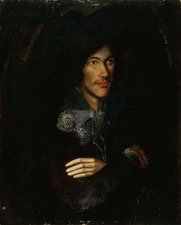 The famous image of John Donne as a melancholy lover, which the National Portrait Gallery has launched an appeal to buy for the nation: http://www.npg.org.uk/live/prjohndonneappeal.asp
The famous image of John Donne as a melancholy lover, which the National Portrait Gallery has launched an appeal to buy for the nation: http://www.npg.org.uk/live/prjohndonneappeal.aspGermaine Greer has clearly been asked to crank something out about this business: her thoughts are in The Guardian, and in the on-line Guardian at http://books.guardian.co.uk/departments/classics/story/0,,1696447,00.html
Now, I have a lot of time and respect for Germaine Greer as a scholar. Her 'Sex and Destiny' book is the one I learned most from, and her art history is important. As a friend to Donne, she is a very valuable person to have on-side. Far too much scholarship on Donne involves the academic carefully positioning herself, or himself, as most especially sensitive to gender politics. In a case like that of Stevie Davies, who did a monograph on Donne for the British Council, the effects can be sad (her account might as well have been titled, 'Why I hate John Donne and all that he stands for'). A contrarian in Dr Greer makes her reluctant to cite Donne only as a negative example. Elegy 19, 'To his Mistress: Going to Bed', usually hauled out these days from its cell to be arraigned for its deplorable attitudes, she saw freshly enough to pitch as a matrimonial poem, in Michael Hattaway's big Blackwell's anthology on Renaissance Literature.
Her present piece on the Donne portrait has the same 'but MY opinion is' type of argument: no, it's not about love melancholy, but this: "I think it relates to the beginning of the long and painful journey that took the poet far from the faith of his childhood, the faith his brother died for, into the strenuous realm of revolutionary Protestantism." The sort of fresh opinion she can be counted upon to give. At issue here is the "Illumina tenebr[as] nostras domina" legend on the picture, usually taken as a fine example of Donne's witty-blasphemous manner: not, 'Lord, lighten our darkness', but 'Lady, lighten our (with 'my' understood) darkness' - redeem me from misery by having (sexual) mercy on me. The Guardian piece leaves the status of the legend floating. An early witness who saw 'Domine' not 'Domina' is cited. Thomas Morton saw only what he expected to see, and saw wrong, as Greer says. 'Domina', then, 'Lady' - well, a Catholic Donne might well have asked the Virgin Mary to show him the light, but that was a request hardly likely to end up with him becoming a Protestant. And (as Greer does register), you could hardly think that even the B.V.M. would be safe in the company of this man.
No, not enough following up on the consequences of her opinion to convince this time around. Donne, who collected pictures, displayed a remarkable control over his own image, from the minature at 18, and on through the portraits of himself as baroque preacher, and up to his famously being sketched posed in his shroud. No, I think Donne, not short of ego, had a gallery of himself. It would have been arranged as a 'Seven Ages of Me' - a lost drawing of JD as infant, Donne at 18, Donne as lover, Donne in early and later middle age, elderly Donne, and Donne (finally) as cadaver.
Of course the NPG should have them all, especially this, the most appealing of them all, 'my picture taken in the shadows'- I will put in my tenner!
No comments:
Post a Comment